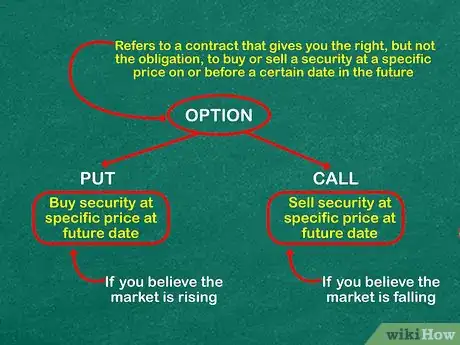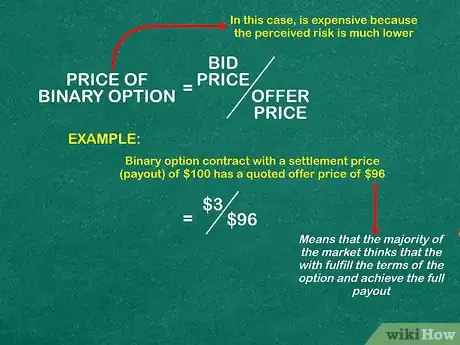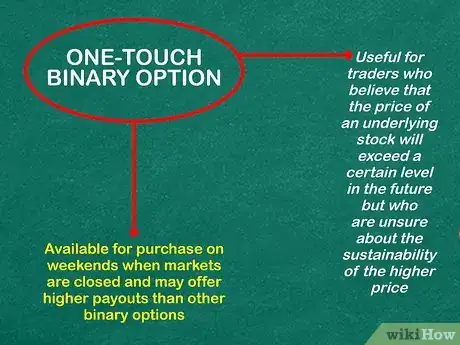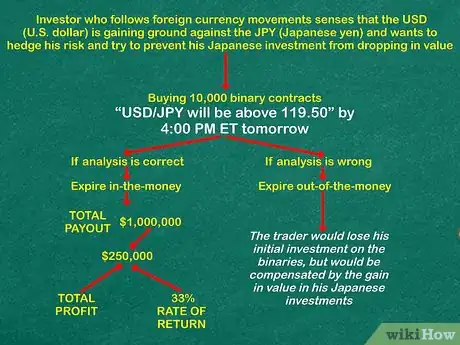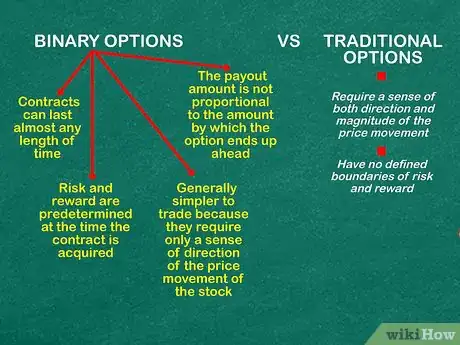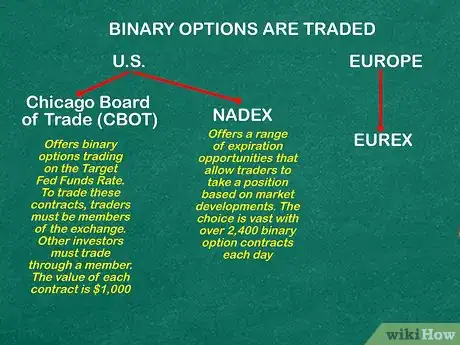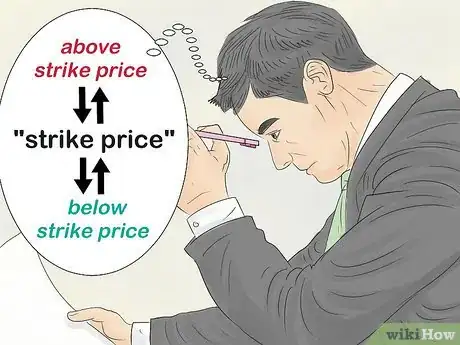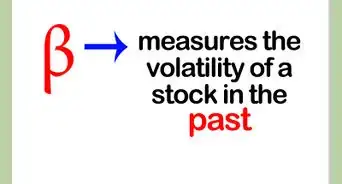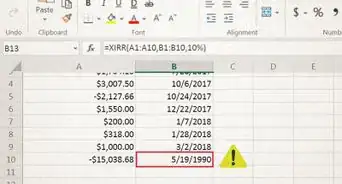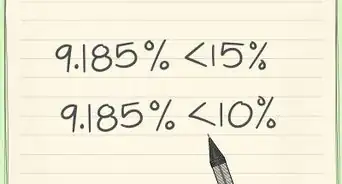This article was co-authored by Michael R. Lewis. Michael R. Lewis is a retired corporate executive, entrepreneur, and investment advisor in Texas. He has over 40 years of experience in business and finance, including as a Vice President for Blue Cross Blue Shield of Texas. He has a BBA in Industrial Management from the University of Texas at Austin.
wikiHow marks an article as reader-approved once it receives enough positive feedback. This article received 13 testimonials and 97% of readers who voted found it helpful, earning it our reader-approved status.
This article has been viewed 767,418 times.
A binary option, sometimes called a digital option, is a type of option in which the trader takes a yes or no position on the price of a stock or other asset, such as ETFs or currencies, and the resulting payoff is all or nothing. Because of this characteristic, binary options can be easier to understand and trade than traditional options.
Steps
Understanding the Necessary Terms
-
1Learn about options trading. An "option" in the stock market refers to a contract that gives you the right, but not the obligation, to buy or sell a security at a specific price on or before a certain date in the future. If you believe the market is rising, you could purchase a "call," which gives you the right to purchase the security at a specific price through a future date. Doing so means you think the stock will increase in price. If you believe the market is falling, you could purchase a "put," giving you the right to sell the security at a specific price until a future date. This means you are betting that the price will be lower in the future than what it is trading for now.[1]
-
2Learn about binary options. Also called fixed-return options, these have an expiration date and time as well as a predetermined potential return. Binary options can be exercised only on the expiration date. If at expiration the option settles above a certain price, the buyer or seller of the option receives a pre-specified amount of money. Similarly, if the option settles below a certain price, the buyer or seller receives nothing. This requires a known upside (gain) or downside (loss) risk assessment. Unlike traditional options, a binary option provides a full payout no matter how far the asset price settles above or below the "strike" (or target) price.
- For instance, if you might bet that the share price of X Company will be above $15 on July 10th at 3pm, and you buy one binary call option for $50 with a predetermined payout of $100. If, at 3pm on July 10th, the share price of X Company is $16, then you will be paid $100 for a $50 profit. If the share price was $14, then you would lose your $50.[2]
- Some binary options will pay out if the share price is met during the determined period. So, if the share price was at $16 at 1pm on July 10th but then dropped to $14 at 3pm, you could still get the $100.
Advertisement -
3Learn how a contract price is determined. The offer price of a binary options contract is roughly equal to the market's perception of the probability of the event happening. The price of a binary option is presented as a bid/offer price that shows the bid (sell) price first and offer (buy) price second, for example, 3/96, which represents a bid price of $3 and an offer price of $96.
- For example, if a binary option contract with a settlement price (payout) of $100 has a quoted offer price of $96, this means that the majority of the market thinks that the underlying commodity with fulfill the terms of the option and achieve the full $100 payout, whether that means going above or sinking below a certain market price.
- This is why the option, in this case, is so expensive; the perceived risk is much lower.[3]
-
4Learn the terms "in-the-money" and "out-of-the-money." For a call option, in-the money happens when the option's strike price is below the market price of the stock or other asset. If it's a put option, in-the-money happens when the strike price is above the market price of the stock or other asset. Out-of-the-money would be the opposite when the strike price is above the market price for calls, and below the market price for a put option.
-
5Understand one-touch binary options. These are a type of option growing increasingly popular among traders in the commodity and foreign exchange markets. This type of option is useful for traders who believe that the price of an underlying stock will exceed a certain level in the future but who are unsure about the sustainability of the higher price. They are also available for purchase on weekends when markets are closed and may offer higher payouts than other binary options.
Trading Binary Options
-
1Know the two possible outcomes. A trader of binary options should have some feel for the anticipated direction in price movement of the stock or other asset such as commodity futures or currency exchanges. Within most platforms the two choices are referred to as "put" and "call." Put is the prediction of a price decline, while call is the prediction of a price increase.
- Unlike traditional options, anticipating the magnitude of a price movement is not required. Instead, one must only be able to correctly predict whether the price of the chosen asset will be higher or lower than the "strike" (or target) price at a specified future time.
-
2Decide your position. Evaluate the current market conditions surrounding your chosen stocks or other asset and determine whether the price is more likely to rise or fall. If your insight is correct on the expiration date, your payoff is the settlement value as stated in your original contract. The return rate on each winning trade is established by the broker and made known ahead of time.
- For example, let's say an investor who follows foreign currency movements senses that the USD (U.S. dollar) is gaining ground against the JPY (Japanese yen) and wants to hedge his risk and try to prevent his Japanese investment from dropping in value. He may do this by buying 10,000 binary contracts which say that “USD/JPY will be above 119.50” by 4:00 PM ET tomorrow. If his analysis is correct and the USD gains ground over the Yen, rising above 119.50, the 10,000 binary contracts will expire in-the-money, yielding a total payout of $1,000,000. If the investor paid $75 per contract, he will make $25 per contract, which is a $250,000 total profit, a 33% rate of return on his investment. However, if the yen does not end above 119.50, the 10,000 binary contracts will expire out-of-the-money. In this case, the trader would lose his initial investment on the binaries, but would be compensated by the gain in value in his Japanese investments.
-
3Learn the advantages of trading binary options over traditional options. Binary options are generally simpler to trade because they require only a sense of direction of the price movement of the stock. Traditional options require a sense of both direction and magnitude of the price movement. No actual stocks are ever bought or sold, so the selling of shares and stop-losses are not part of the process.
- A stop-loss is an order you would place with a stock broker to buy or sell once the stock hits a certain price.[4]
- Binary options always have a controlled risk-to-reward ratio, meaning the risk and reward are predetermined at the time the contract is acquired. Traditional options have no defined boundaries of risk and reward and therefore the gains and losses can be limitless.
- Binary options can involve the trading and hedging strategies used in trading traditional options. You should always conduct a market analysis prior to each trade. There are many variables to consider when trying to decide whether the price of a stock or other asset is going to increase or decrease within a specific time period. Without analysis, the risk of losing money increases substantially.
- Unlike a traditional option, the payout amount is not proportional to the amount by which the option ends up ahead. As long as a binary option settles ahead by even one tick, the winner receives the entire fixed payoff amount.
- Binary options contracts can last almost any length of time, ranging from minutes to months. Some brokers provide contract times of as short as thirty seconds. Others can last a year. This provides great flexibility and almost unlimited money-making (and money-losing) opportunities. Traders must know exactly what they're doing.[5]
Understanding Costs and Where to Buy
-
1Learn where binary options are traded. Binary options are enormously popular in Europe and are extensively traded in major European exchanges, like EUREX. In the United States there are a few places where binary options can be traded:
- The Chicago Board of Trade (CBOT) offers binary options trading on the Target Fed Funds Rate. To trade these contracts, traders must be members of the exchange. Other investors must trade through a member. The value of each contract is $1,000.
- Nadex is a U.S.-regulated binary options exchange. Nadex offers a range of expiration opportunities (hourly, daily, weekly) that allow traders to take a position based on market developments. The choice is vast with over 2,400 binary option contracts each day. These range from popular currency pairs (such as Great Britain Pound/USD) to key commodities like gold and oil. Members' funds are held in a segregated U.S. bank account in accordance with Commodities Futures Trading Commission (CFTC) regulations, adding an extra layer of security.
-
2Check for transaction costs and potential profits. Binary options brokers should not charge any per-trade fees, nor should they collect any commissions. You should also understand the percentage of time would you have to be correct in order to profit from the binary option you are considering.
- For example, if you were buying into options at for $40 each and each one has a settlement value of $100 if you are correct, you would need to be correct 2 out of 5 times to break even, and more often than that to turn a profit (cost: 5*$40=$200, return: 2*$100=$200).
- Screen several brokers before making a selection. Each broker is going to provide his or her own trading platform, contract terms, assets, return rates, and educational resources. Each of these elements can have an impact on overall earnings potential.
-
3Know the transaction costs ahead of time. It is extremely rare and difficult to outperform the market consistently. That means that options traders typically have to engage in many transactions in order to wind up with a profitable position. Consequently, a trader faces the possibility of high transaction costs and lower profits.
-
4Understand the trading terms for each deal. How different are the terms (for instance, "strike price") on one side of the trade (above strike price) compared to the reverse side (below strike price)? If they are significantly different, the buyer would be forced into the unusual position of having to predict the magnitude as well as the direction of a price movement.
Warnings
- If the above description makes binary option trading sound like gambling, that's because it is. Binary options are quite similar to placing bets in a casino. It is possible to make money in a casino or in trading options, but either game requires knowledge, skill, experience and strong nerve. Make sure you get enough experience trading options in order to make money consistently in trading either traditional or binary options.⧼thumbs_response⧽
- Resist the temptation to accept bonuses from the broker. Bonuses are basically free money given to binary options traders on certain online trading platforms. However, these bonuses will magnify your losses as quickly as they can increase your winnings, potentially causing you to blow your initial investment much faster in a small amount of bad trades. In addition, the bonuses may come with terms that require you to invest a certain number of times before withdrawing your money, or other restrictive rules.⧼thumbs_response⧽
References
- ↑ http://www.investopedia.com/university/options/option.asp
- ↑ http://www.investopedia.com/terms/b/binary-option.asp
- ↑ http://www.nadex.com/trade-binary-options.html
- ↑ http://www.investopedia.com/articles/stocks/09/use-stop-loss.asp
- ↑ http://www.investopedia.com/articles/optioninvestor/10/binary-options.asp
